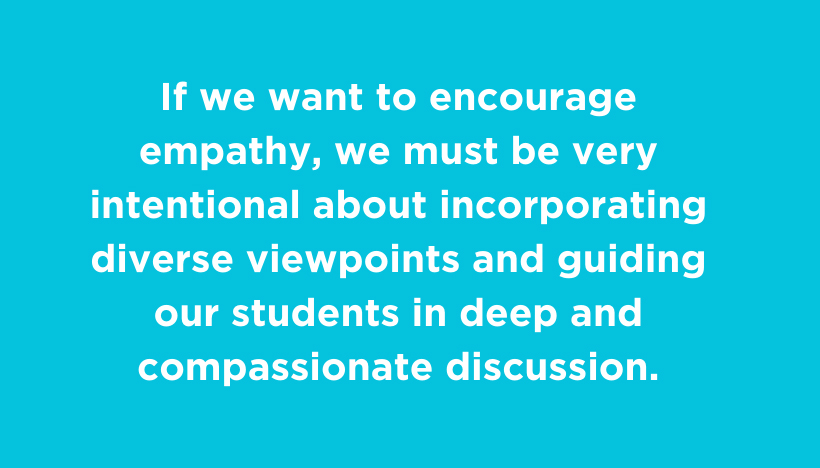Julie Griggs and Heather Hooks, the 2020 NCTE Media Literacy Award winners, were honored at a virtual ceremony in October 2020 for their work developing Engaging Empathy.org, a website integrating the artwork and library resources of Crystal Bridges Museum of American Art in lessons to strengthen empathy and literacy in secondary schools. In this post, Julie and Heather describe how their work developed and what they hope it offers teachers and students.
How did Engaging Empathy begin?
In 2014, Heather began the three-year ARTeacher Fellowship with the University of Arkansas Center for Children and Youth, Crystal Bridges Museum of American Art, and the Walton Arts Center, and she was developing her arts integration curriculum with a variety of activities. Students analyzed artworks using Visible Thinking Strategies such as See Think Wonder, a strategy which promotes evidence-based inferences and engaging discussion. Students then applied the same approach to complex texts. Heather incorporated the Actor’sToolbox, an opening routine developed by Sean Lane of Focus 5, Inc. to help calm and center students to create a strong classroom community. Students created tableau, posing as motionless figures, to share key ideas from texts and performed Readers Theater to understand the complex issues of civil rights explored in Martin Luther King Jr.’s speech Why We Can’t Wait.
That same year, Julie was exploring empathy with her classes. Students’ interest was sparked by the power of reading, and as classes collaborated to identify additional perspectives and experiences, she began searching for texts to match their interests. She discovered that often the most powerful text was found in painting, film, music, or sculpture rather than in traditional print text.
We (Heather and Julie) were both excited about the engagement and growth we witnessed in our classes, and we frequently shared stories and strategies. When Julie joined the ARTeacher Fellowship the following year, we began to weave empathy and arts integration together in our curriculum. In 2019, we accepted the Reese Fellowship with the William Reese Company and Crystal Bridges Museum of American Art, in which we created engagingempathy.org to share lessons with other teachers.
What does the Engaging Empathy website offer?
Engaging Empathy offers eleven topics—including African American Perspectives, Economic Inequality, Environmental Issues, Gender Perspectives, Indigenous Peoples’ Perspectives, LGBTQ+ Perspectives—with multiple lessons for each topic. Each lesson includes background on the topic, artist, and artwork; an art analysis strategy; and a literacy extension activity. We wanted to support teachers looking for a detailed lesson to implement quickly, but we also designed the lessons for customization.
What makes this curriculum relevant now?
If you read about empathy, you’ll quickly encounter research showing that empathy has been declining for many years. Beyond the research, we see it in our daily lives—a quickness to judge, a resistance to dialogue, a lack of kindness. If we want to encourage empathy, we must be very intentional about incorporating diverse viewpoints and guiding our students in deep and compassionate discussion.
Additionally, media literacy is literacy. Whether choosing a college or purchasing a car or electing a president, our students will be encountering messages in a wide variety of mediums. Many of them may even rely on nonprint texts more than traditional print texts, and we must prepare them to be wise in analyzing messages in any medium.
How does the Engaging Empathy curriculum advance media literacy?
As English teachers with arts integration backgrounds, we naturally conceived Engaging Empathy as a project that would promote arts enrichment in English classrooms, but the lessons have evolved to serve media literacy across the curriculum. We’ve helped world language teachers incorporate portraiture projects, we’re learned that science teachers modified our quilt square project to explore biodiversity, and we’ve presented our lessons for the National Council for History Education.
One of our hopes is that Engaging Empathy will help teachers see how easy and effective it can be to incorporate media literacy. When we first began searching for empathy texts, we knew we couldn’t read book-length works for every perspective we hoped to explore, and we also knew we would likely encounter copyright issues with texts.
Going beyond print texts opened up many powerful possibilities for our curriculum. Images and film clips can usually be analyzed and discussed more quickly than traditional texts, and students connect with them easily and enjoy the lessons.
What feedback have you received from students?
Probably the most frequent comment we hear from students is the sense of community they feel. In 2015, Julie had two students who were football players and had been adopted out of the foster care system after some hard experiences. They seemed like longtime friends, but they told us that their friendship had formed entirely in our class. They had never before shared their experiences with a classmate or a teacher, but the nature of our class helped them to tell their stories. Other students shared about homelessness, addiction, and incarceration in their families, and their openness transformed our classroom. We both believe that students read, discuss, and write more authentically when they feel safe and understood.
Find Engaging Empathy lessons and learn more here.
 Julie Griggs holds a Bachelor of Arts in English and a Master of Arts in Teaching from the University of Arkansas. As one of the 2019 Reese Fellows at Crystal Bridges, Julie co-created Engaging Empathy (engagingempathy.org), an arts-enriched literacy and empathy curriculum for exploring diverse perspectives and experiences in secondary classrooms. Julie has presented on literacy practices, empathy, arts integration, and standards-based learning for her district, region, and state, as well as the National Council of Teachers of English and National Council for History Education. Julie is a teacher at Bentonville High School and serves on the Teacher Advisory Board for Crystal Bridges.
Julie Griggs holds a Bachelor of Arts in English and a Master of Arts in Teaching from the University of Arkansas. As one of the 2019 Reese Fellows at Crystal Bridges, Julie co-created Engaging Empathy (engagingempathy.org), an arts-enriched literacy and empathy curriculum for exploring diverse perspectives and experiences in secondary classrooms. Julie has presented on literacy practices, empathy, arts integration, and standards-based learning for her district, region, and state, as well as the National Council of Teachers of English and National Council for History Education. Julie is a teacher at Bentonville High School and serves on the Teacher Advisory Board for Crystal Bridges.
 Heather Hooks has a Bachelor of Arts and Master of Arts in English from the University of Central Florida, and has just completed a doctoral degree in School Leadership from Arkansas Tech University. In 2019, Heather was named one of two Reese Fellows for the William Reese Teacher Fellowship, and co-created Engaging Empathy (engagingempathy.org) to provide arts-enriched empathy curriculum for teachers at the secondary level. Additionally, Heather has presented at local, state, and national conferences (including NCTE and NCHE) on topics such as arts integration, standards-based learning, technology, and empathy. Heather serves on the Teacher Advisory Board for the Crystal Bridges Museum of American Art and as assistant principal at Bentonville High School.
Heather Hooks has a Bachelor of Arts and Master of Arts in English from the University of Central Florida, and has just completed a doctoral degree in School Leadership from Arkansas Tech University. In 2019, Heather was named one of two Reese Fellows for the William Reese Teacher Fellowship, and co-created Engaging Empathy (engagingempathy.org) to provide arts-enriched empathy curriculum for teachers at the secondary level. Additionally, Heather has presented at local, state, and national conferences (including NCTE and NCHE) on topics such as arts integration, standards-based learning, technology, and empathy. Heather serves on the Teacher Advisory Board for the Crystal Bridges Museum of American Art and as assistant principal at Bentonville High School.

